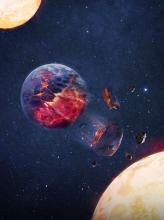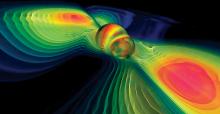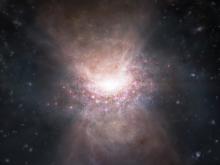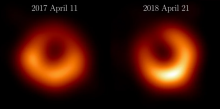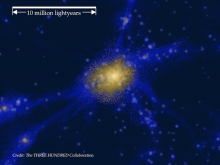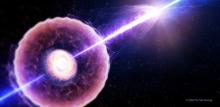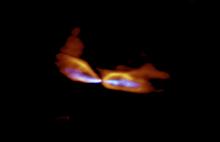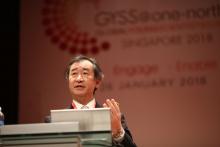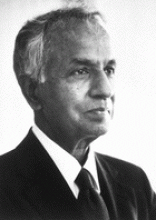Space sciences Astrophysics
News
27 Feb 2024
Jun’ichi Yokoyama once amused his professors by proposing a far-fetched idea of using neutrinos and gravitational waves to observe the Universe. Decades later, he was proven right and contends young scientists should be nurtured to believe in themselves.
01 Feb 2024
Theoretical predictions have been confirmed with the discovery of an outflow of molecular gas from a quasar when the Universe was less than a billion years old.
19 Jan 2024
A recent paper published in the journal Astronomy & Astrophysics presents new images from the 2018 data that reveal a familiar ring the same size as observed in 2017. This bright ring surrounds a deep central depression, “the shadow of the black hole,” as predicted by general relativity. Excitingly, the peak brightness of the ring has shifted by about 30º counter clockwise compared to its position in 2017, which is consistent with our theoretical understanding of the variability of the turbulent material around black holes.
10 Apr 2023
AI finds the first stars ✨were not alone, Auto-switch for large electronic devices, A metabolite against autoimmune diseases, & Converting fruit waste 🍊🍉into solar stills. Plus in our blog: A career worth doing, a life worth living. Read all in the latest Editor's Choice.
15 Mar 2023
A team led by Kavli IPMU researchers have found the earliest evidence of parts of the universe that were heated to temperatures more characteristic to the intergalactic gas medium where most atoms reside in the universe today.
28 Feb 2023
Osaka Metropolitan University scientists identified about 140,000 molecular clouds in the Milky Way Galaxy from large-scale data of carbon monoxide molecules, observed in detail by the Nobeyama 45-m radio telescope. Using artificial intelligence, the researchers estimated the distance of each of these molecular clouds to determine their size and mass, successfully mapping the distribution of the molecular clouds in the Galaxy in the most detailed manner to date.
19 Dec 2022
When stars die out, they emit gamma-ray bursts. Although scientist can calculate the explosion energy from dying stars, it is difficult to do when the conversion efficiency is low or unknown. Using light polarization, a research group has found a workaround for this, enabling astronomers to calculate the hidden energy of gamma-ray bursts.
29 Aug 2022
Researchers at Osaka Metropolitan University have observed "baby stars" in the Small Magellanic Cloud, having an environment similar to the early universe. Toward one of the baby stars, they found molecular outflow, which has similar properties to those seen in the Milky Way galaxy, giving a new perspective on the birth of stars.
27 Aug 2019
Chair Professor Il Soon Hwang, who joined the School of Mechanical Aerospace and Nuclear Engineering at South Korea's Ulsan National Institute of Science and Technology (UNIST), has been selected to lead the 'Nuclear Convergence Technology Development' project by the Ministry of Science and ICT (MSIT) and National Research Foundation (NRF).

22 Mar 2019
The Hong Kong University of Science and Technology (HKUST) (HKUST) will build a new kind of camera using a new approach of quantum optics. The camera is set to help solve unanswered questions in astrophysics and cosmology, such as how light originates and varies around the black hole, in the hope of deciphering information emitted from there.
26 Feb 2019
Astronomers have unveiled the origins of two different gas streams from a baby star. Using ALMA, they found that the slow outflow and the high speed jet from a protostar have misaligned axes and that the former started to be ejected earlier than the latter. These indicate that streams were launched from different parts of disk around the protostar.
29 Jan 2018
The new Japanese facility, to be ready by the year’s end, will be Asia’s first detector and the world’s first below ground
Events
Sorry, nothing coming up for this discipline
Researchers
Miho Katsuragawa is a specially appointed project researcher at Kavli IPMU. Her areas of expertise include experimental physics, detector/instrument development, medical application of gamma-ray imaging, and high energy astrophysics.
Giants in history
Subrahmanyan Chandrasekhar (19 October 1910 – 21 August 1995) was an Indian astrophysicist who studied the structure and evolution of stars.


